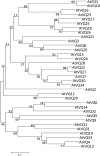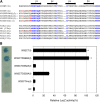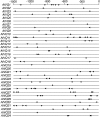Structural and functional analysis of VQ motif-containing proteins in Arabidopsis as interacting proteins of WRKY transcription factors
- PMID: 22535423
- PMCID: PMC3375943
- DOI: 10.1104/pp.112.196816
Structural and functional analysis of VQ motif-containing proteins in Arabidopsis as interacting proteins of WRKY transcription factors
Abstract
WRKY transcription factors are encoded by a large gene superfamily with a broad range of roles in plants. Recently, several groups have reported that proteins containing a short VQ (FxxxVQxLTG) motif interact with WRKY proteins. We have recently discovered that two VQ proteins from Arabidopsis (Arabidopsis thaliana), SIGMA FACTOR-INTERACTING PROTEIN1 and SIGMA FACTOR-INTERACTING PROTEIN2, act as coactivators of WRKY33 in plant defense by specifically recognizing the C-terminal WRKY domain and stimulating the DNA-binding activity of WRKY33. In this study, we have analyzed the entire family of 34 structurally divergent VQ proteins from Arabidopsis. Yeast (Saccharomyces cerevisiae) two-hybrid assays showed that Arabidopsis VQ proteins interacted specifically with the C-terminal WRKY domains of group I and the sole WRKY domains of group IIc WRKY proteins. Using site-directed mutagenesis, we identified structural features of these two closely related groups of WRKY domains that are critical for interaction with VQ proteins. Quantitative reverse transcription polymerase chain reaction revealed that expression of a majority of Arabidopsis VQ genes was responsive to pathogen infection and salicylic acid treatment. Functional analysis using both knockout mutants and overexpression lines revealed strong phenotypes in growth, development, and susceptibility to pathogen infection. Altered phenotypes were substantially enhanced through cooverexpression of genes encoding interacting VQ and WRKY proteins. These findings indicate that VQ proteins play an important role in plant growth, development, and response to environmental conditions, most likely by acting as cofactors of group I and IIc WRKY transcription factors.
Figures










References
-
- Asai T, Tena G, Plotnikova J, Willmann MR, Chiu WL, Gomez-Gomez L, Boller T, Ausubel FM, Sheen J. (2002) MAP kinase signalling cascade in Arabidopsis innate immunity. Nature 415: 977–983 - PubMed
-
- Chandra-Shekara AC, Gupte M, Navarre D, Raina S, Raina R, Klessig D, Kachroo P. (2006) Light-dependent hypersensitive response and resistance signaling against Turnip Crinkle Virus in Arabidopsis. Plant J 45: 320–334 - PubMed
Publication types
MeSH terms
Substances
LinkOut - more resources
Full Text Sources
Other Literature Sources
Molecular Biology Databases
Research Materials

